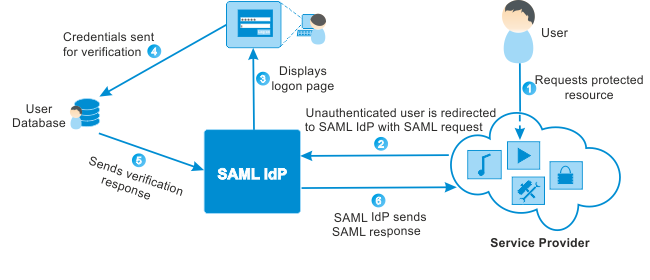How Does SAML Work?

What is SAML?
SAML stands for Security Assertion Markup Language. This is an open authorization credential standard that makes it possible for a single credential system to be used for multiple websites. As many companies are now using an extraordinary number of integrated, online applications throughout their ecosystems, SAML becomes important. Not only is it easier for employees to remember only a single login rather than a multitude of logins — it’s also easier to secure. A single log-in means that only one point of failure has to be managed, whereas employees can easily lose track of their information or introduce weaknesses with multiple log-ins.
There are other authentication protocols, such as OpenID Connect, and the related OAuth 2.0. However, SAML has some advantages over these solutions, being a targeted, direct authentication service, being lightweight, and being easy to use. SAML has also been developed (redesigned to 2.0) in recent years to be even more powerful and to support single sign-on in even more extensive and advanced network configurations.
That’s what SAML is. But how does SAML work? While SAML is conceptually simple, the technology behind it is quite robust.
How Does SAML Work?
SAML uses XML (eXtensible Markup Language) to create universal credential files which can then be used throughout the SAML system. SAML standards provide for single-sign-on which operates through a singular SAML service provider. So while the SAML files themselves are universal, authentication services are still run through a single, authenticated, and secured platform. Ultimately, this improves upon security and consistency. SAML is frequently used with Microsoft Active Directory, Azure, Salesforce, and other CRM and ERP solutions.
Step by step, the user will sign into the SSO and then go to the application. The service provider will check the credentials that were passed along, and then the identity provider will send authorization and authentication messages to the service provider. From there, the user will be logged into the application.
SAML is relatively easy for an organization to set up — as long as the applications have SAML support. SAML can be installed and configured through Microsoft Active Directory, open-source PHP authentication applications, and other authentication services. Once installed, the application is intuitive and simple on the user side — and can be administered through Active Directory and other SAML applications.
SAML vs. OAuth
What about SAML vs. OAuth? OAuth is an open authorization standard rather than an authentication standard. To be specific, SAML will ensure that users have logged into the application correctly, that their provided credentials are accurate, and their credentials can operate as a single sign-on for the utilities within the network. Comparatively, OAuth makes sure to send users to the right place, ensuring that the resources that they access are correct. SAML and OAuth can be used together and are not the same utility, though the services between authentication and authorization are both security services that need to be managed properly by the organization.
SAML 2.0 Authentication
Here’s how SAML 2.0 Authentication works. SAML 2.0 is like SAML but it’s designed to provide for authentication between security domains. Both authentication and authorization are exchanged. SAML 2.0 replaced SAML 1.1 and is such a significant change that SAML 1.1 documents are not cross-compatible with SAML 2.0. SAML has three types of defined statements: authentication assertion, attribution assertion, and authorization decision assertion.
SAML is an excellent solution for organizations that need a single sign-on solution, rather than continually juggling authentication services. With SAML, organizations are able to manage all their authentication through a single service, and that greatly reduces the amount of administration time the organization has to spend on its authentication systems. Moreover, it also improves security by creating only a single authentication system that has to be managed.

























